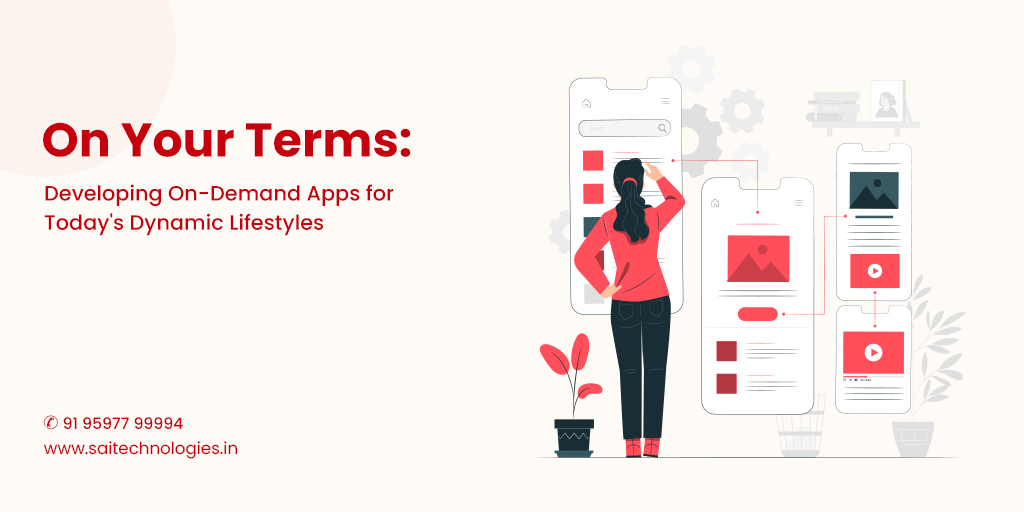On Your Terms
Developing On-Demand Apps for Todays Dynamic Lifestyles

In an era characterized by rapid digitalization and changing consumer preferences, on-demand apps have emerged as a cornerstone of modern convenience. These applications cater to our fast-paced lifestyles, providing instant access to services, products, and experiences. From ride-hailing and food delivery to healthcare and home services, the on-demand economy has revolutionized the way we interact with businesses. In this blog post, we will delve into the diverse landscape of on-demand business models and explore how developing such apps is shaping our dynamic lifestyles.
The Rise of On-Demand Economy
The on-demand economy, often referred to as the "Uber for X" model, has disrupted traditional business models across various sectors. Enabled by technology and mobile connectivity, these apps connect consumers directly with service providers, eliminating intermediaries and streamlining transactions. The on-demand economy offers benefits not only to consumers seeking convenience but also to individuals looking for flexible income opportunities.
-
Transportation and Ride-Hailing Apps
Ride-hailing apps were among the pioneers of the on-demand economy, transforming the way we move around cities. Platforms like Uber and Lyft connect passengers with drivers through user-friendly apps, allowing for real-time ride booking, tracking, and cashless payments. This model has disrupted the taxi industry and introduced new levels of convenience and transparency.
-
Food Delivery and Culinary Experiences
Food delivery apps have revolutionized how we access meals. With just a few taps, users can order food from local restaurants and have it delivered to their doorstep. These apps offer a wide range of cuisines and dining options, catering to various tastes and preferences. Some platforms even offer subscription-based services for regular meal deliveries.
-
Home Services and Maintenance
On-demand apps have extended their reach to home services, making household tasks more manageable. Users can book services such as house cleaning, plumbing, and handyman work through these apps. The model provides consumers with access to skilled professionals without the hassle of traditional scheduling processes.
-
Healthcare and Telemedicine
Telemedicine apps have gained prominence, especially in the wake of global health challenges. These apps connect patients with medical professionals through video calls, offering consultations, prescriptions, and medical advice from the comfort of home. This on-demand healthcare model enhances accessibility and reduces the strain on traditional healthcare systems.
-
Personal Shopping and Retail
On-demand retail apps offer personalized shopping experiences. Users can browse, choose, and purchase products, which are then delivered directly to their doorsteps. Some platforms even offer same-day or express delivery options, catering to consumers' desire for instant gratification.
-
Beauty and Wellness
Beauty and wellness on-demand apps bring professionals directly to consumers. Services like at-home massages, hairstyling, and beauty treatments are easily accessible through these platforms. This model offers convenience and privacy to users who prefer personalized services in their own space.
-
Entertainment and Media Streaming
Media streaming platforms have embraced the on-demand model, allowing users to access a vast library of content at their convenience. With apps like Netflix, Spotify, and Audible, users can watch movies, listen to music, and enjoy audiobooks on their own terms.
-
Logistics and Delivery Services
Beyond food delivery, on-demand apps have expanded into the logistics sector. Package delivery, courier services, and even grocery deliveries are made more efficient through these platforms. Users can track their deliveries in real time and receive updates on the status of their packages.
Developing On-Demand Apps: Key Considerations
Creating successful on-demand apps requires careful planning, design, and execution. Here are some key considerations for developers looking to enter the on-demand app landscape:
-
User-Centric Design
Prioritize a user-friendly interface that guides users through the app's features and services. Intuitive navigation, clear call-to-action buttons, and a seamless booking process are crucial for a positive user experience.
-
Real-Time Updates
On-demand apps thrive on real-time information. Users should receive timely updates on service availability, estimated arrival times, and any changes to their bookings.
-
Secure Payments
Implement secure and convenient payment gateways to facilitate cashless transactions. Users should feel confident that their payment information is protected.
-
Rating and Feedback System
Include a rating and feedback system for users to share their experiences. This helps maintain quality control and build trust between users and service providers.
-
Geolocation and Mapping
Geolocation technology is at the core of on-demand apps. Integration with mapping services ensures accurate tracking of service providers and deliveries.
-
Service Provider Onboarding
For apps connecting users with service providers, a streamlined onboarding process is essential. This includes background checks, verification, and training.
-
Scalability
Plan for scalability as user demand grows. Ensure your app's infrastructure can handle increased traffic and service requests without compromising performance.
-
Regulatory Compliance
Be aware of relevant regulations and legal considerations in the industry you're entering. Compliance with local laws and regulations is essential for a sustainable business.
The Evolution of Convenience
As technology continues to advance and user expectations evolve, the on-demand economy will likely continue to expand into new sectors. From education to finance, the potential for on-demand apps to reshape industries is vast. This evolution reflects a fundamental shift in how we perceive and interact with services – it's not just about getting what we want when we want it; it's about having control over our choices and experiences.
In conclusion, on-demand apps have become an integral part of our dynamic lifestyles, offering convenience, flexibility, and personalized experiences. The diverse range of on-demand business models showcased in this article highlights the adaptability and innovation present in today's digital landscape. As developers and entrepreneurs continue to tap into the on-demand economy, the future promises a world where services and products are tailored to our preferences and delivered on our terms.

